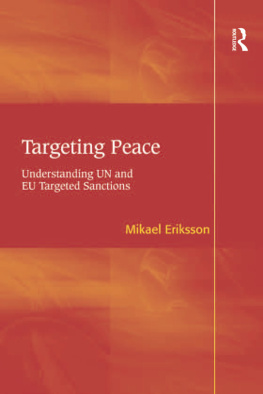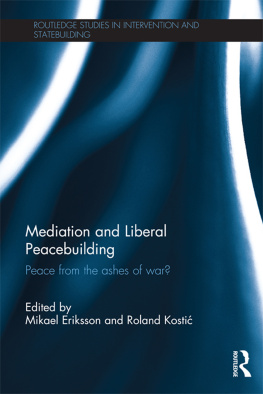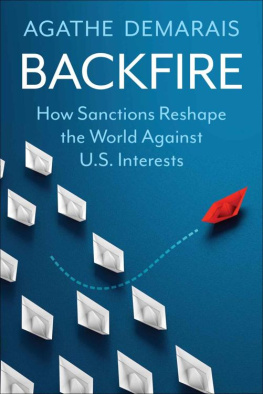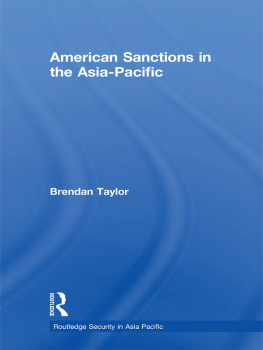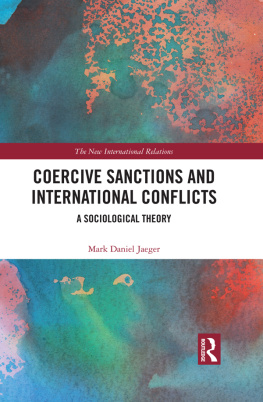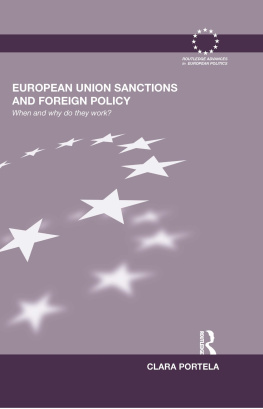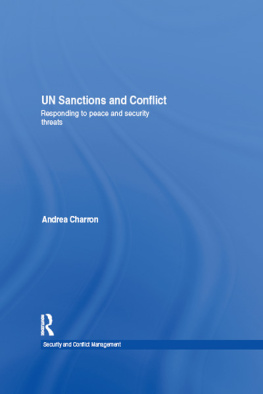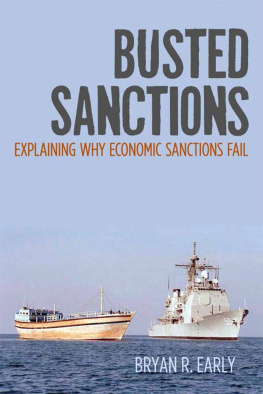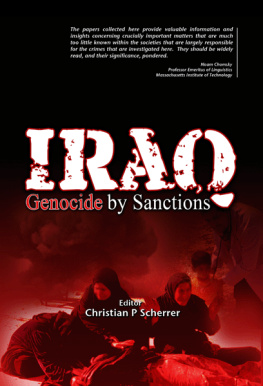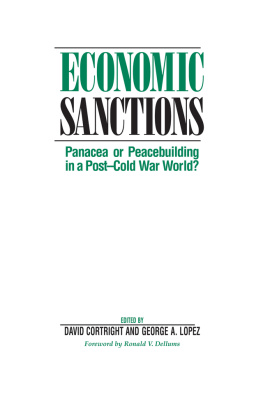TARGETING PEACE
To Klara Smedberg
Targeting Peace
Understanding UN and EU Targeted Sanctions
MIKAEL ERIKSSON
First published 2011 by Ashgate Publishing
Published 2016 by Routledge
2 Park Square, Milton Park, Abingdon, Oxon OX14 4RN
711 Third Avenue, New York, NY 10017, USA
Routledge is an imprint of the Taylor & Francis Group, an informa business
Copyright Mikael Eriksson 2011
Mikael Eriksson has asserted his right under the Copyright, Designs and Patents Act, 1988, to be identified as the author of this work.
All rights reserved. No part of this book may be reprinted or reproduced or utilised in any form or by any electronic, mechanical, or other means, now known or hereafter invented, including photocopying and recording, or in any information storage or retrieval system, without permission in writing from the publishers.
Notice:
Product or corporate names may be trademarks or registered trademarks, and are used only for identification and explanation without intent to infringe.
British Library Cataloguing in Publication Data
Eriksson, Mikael.
Targeting peace : understanding UN and EU targeted sanctions.
1. United Nations--Sanctions. 2. European Union countries--Foreign relations. 3. Sanctions (International law)
I. Title
327.1'17-dc22
Library of Congress Cataloging-in-Publication Data
Eriksson, Mikael.
Targeting peace : understanding UN and EU targeted sanctions / by Mikael Eriksson.
p. cm.
Includes index.
ISBN 978-1-4094-1932-7 (hardback)
1. Sanctions (International law) 2. Economic sanctions--European Union countries. I. Title.
KZ6373.E75 2010
341.5'82--dc22
2010028223
ISBN 9781409419327 (hbk)
Contents
Acknowledgements
The Swedish Research Council (Vetenskapsrdet) and the European University Institute, Italy, have provided generous support to make this book possible. Without their financial and logistical support, this book would not have been written. Financial support has also been made available from the Swedish Institute and the Nordic Africa Institute (both in Sweden). Special gratitude is owed to Professor Pascal Vennesson. Without his comments, my study would be clouded in ambiguities. In addition, I would like to express my appreciation to Professor Friedrich Kratochwil for widening my scientific horizons.
Over the years, a numbers of scholars and experts have also commented or exchanged ideas on various drafts and conference papers throughout the writing process. A special thanks to Professor Peter Wallensteen for his support throughout my academic career. Not only is he an excellent global research entrepreneur and a norm diffuser, but also a close colleague and friend. Thanks also to Professor Thomas Biersteker, Professor David Cortright, the Honourable Sue Eckert, Professor George Lopez, Professor Iain Cameron and Associate Professor Peter Viggo Jakobsen. Along the way, several researchers at the European University Institute have provided me with excellent comments.
My research also included a number of field trips to study sanctions more closely (for example, to Angola, Zimbabwe, Moldova/Transdniestria, Malaysia, Thailand, Ivory Coast, Liberia and Sierra Leone). These missions were enabled by a combination of support from the Swedish Foreign Ministry, staff of the United Nations, and local NGOs (such as the Human Rights Trust of Southern Africa, SAHRIT). During the writing process I also had the chance to spend six months at the EU Commission/DG RELEX (Spring 2007). Not only did it bring new friendships, but also profound insights into the process of EU sanctions policies. In particular, I would like to thank Albertus Straver and Alyson King for taking the time to explain the logic of the EUs restrictive measures. In 2008, I was fortunate to spend time at New York Universitys Center on International Cooperation. My stay there was very enriching.
Many thanks, too, to the most helpful editorial staff at Ashgate publishing. Especially Elaine Couper, and to Huw Jones for his copy-editing
Last but not least, friendship is important when seas become stormy. Here I would like to mention Dr Niklas Rossbach, Stefan Borg, Dr Evelyn Huebscher, Dr Fredrik Thomasson, Dr Roland Kosti and Jesper Sundien, for their support.
Chapter 1
Targeting Peace
Following the end of the Cold War, the United Nations (UN) and the European Union (EU), as well as their respective member states in their own capacities, each shifted from comprehensive to targeted sanctions. This policy shift opened up a new area of sanctions research and invited new approaches to the analysis of this tool.
Targeted sanctions involve measures such as financial sanctions, travel bans, arms embargoes, trade sanctions, flight bans, admissions restrictions, diplomatic sanctions, boycotts, as well as a number of specific measures applied on rough diamonds and timber, and so on. These measures are adopted and implemented in order to deal with domestic and international crises, as well as armed conflicts.
With all of the above in mind, what underpins the current use of targeted sanctions is the rationale of avoiding harm to those actors that are not responsible
The shift in sanctions practice also makes it possible to differentiate between three different application areas. A distinction can be made between: (1) sanctions targeted against individuals, groups or corporate entities (such as against senior military officials in Burma/Myanmar, weapons traders such as Victor Bout, organisations like Hamas, or private companies like Iranian banks); (2) sanctions targeted against particular commodities or sectors of an economy (such as timber sanctions in Liberia, arms embargoes on former Yugoslavia, bans on rough diamonds under the Kimberly scheme, or the luxury goods ban in North Korea), and (3) sanctions targeted against certain regions of a country (such as the arms embargo against groups active in the Eastern Democratic Republic of Congo).
In this study, I will limit the focus to sanctions adopted against individuals. Compared to conventional sanctions that are mostly applied to entire states, individually applied sanctions present a specific research puzzle compared to comprehensive sanctions, as they are able to think, act and respond to the polices adopted by the sender. This brings in a number of new factors in assessing the effectiveness of sanctions which have traditionally been left out of the literature. As noted by Chesterman and Pouligny: A micro sociology of local actors, of their interests and strategies, is necessary to understand their different reactions when sanctions are imposed.
This shift in focus also jibes well with a humanisation trend in international politics and contemporary international law, where there is a clear increase in the pursuit of personal responsibility and judicial accountability of natural entities and official decision-makers. Professor Sikkink, who refers to an ongoing international justice cascade where attention is put on individual decision-makers, has also made a similar observation.
Returning to the shift in practice of targeted sanctions, as noted at the outset, there is still a fundamental puzzle that remains unsolved for sanctions scholars in understanding the utility of targeted sanctions. How should sanctions scholars go about evaluating this new form of sanctions practice? This and related questions make up the focus of this study, which will focus on the UN and the EU. This choice was made because they are the most significant multi-party actors in the sanctions field today.

